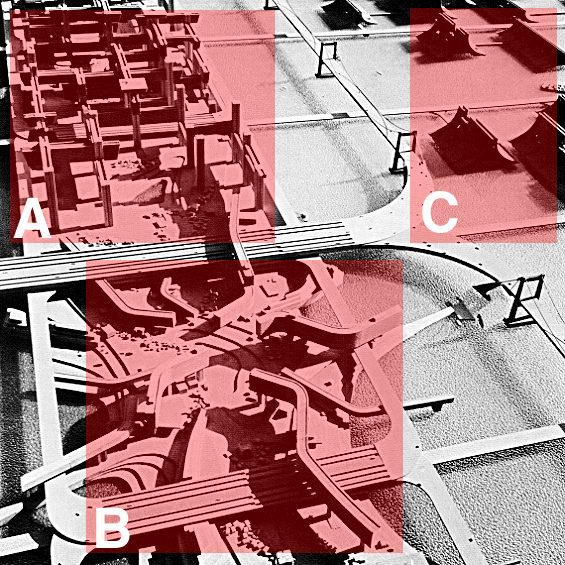Introduction to Kenzo Tange's Plan for Tokyo
Written by Paul Keel
Last Update 02/05/01 T.N.
table of contents

I have chosen the analysis of Kenzo Tange's Plan for Tokyo as the final project in MIT course 4.204 (The Unbuilt Monuments). My reasons for this decision are based on my interests on new city forms that reflect our present technological developments and contemporary way of living.
I intend to divide the process into three steps:
1) Building up a background in the theory of city form, analyzing Kenzo Tange's Plan for Tokyo, and deriving conclusions.
2) Dividing the project into sections, analyzing those according to its grammatical rules and vocabulary to obtain a basis that allows the transformation of some design concepts into computer algorithms.
3) Programming some parts according to the pervious analysis and comparing the results with the original project.
The following brief introduction is part of step 1 and based on some readings about the project.
Over the past few thousand year's cities spread out from the center and the size of a city was for a long time limited to a walkable proportion. After the development of cars and other fast transportation media's cities became bigger and satellite cities evolved. Simultaneously we experienced an incredible increase of the population growth as well as an increased density of people living together. Cities kept growing today and the accessibility of city centers became more and more of a problem. It is proposed that because of modern communication technologies fewer people will find it necessary to access the city center and that a decentralized system of communities will evolve. This raises two major questions: What happens to the cities? And how will the necessary physical contact between these communities look like?
The transformation from a centralized city into a liner city as in Kenzo Tange's project where communities and smaller towns would settle along a main axis appears as a very obvious and useful solution for Tokyo. Unlike in the virtual world, in our physical world distance matters and many common services such as food supplies have no replacement in virtuallity. Therefore, to think about the Tokyo of tomorrow as a linear system with many smaller centers and people living along the axis working for decentralized firms without loosing the opportunity for physical interaction is a very reasonable conclusion to the problem. Tokyo is lucky to be located next to a bay that allows for a linear expansion.

Let me introduce Kenzo Tange's Tokyo expansion project in more and divided the design into four major parts:
1) The connection between Tokyo and the proposed linear expansion:
The first step in creating the civic axis is the construction of a cycle transportation system in a height of 40 meters above existing Tokyo that only touches the ground at points of interchanges. This system connects to all major highways and railroads. The plan shows the beautiful integration of the new transportation system into the existing one.

2) The traffic circulation along the civic axis:
The traffic circulation system is detached from the ground and suggests a strong separation between traffic and pedestrians. It is designed to carry up to 5,000,000 people daily. The grid on which the street system is based on consists of squares with side length of one kilometer. The system allows for a step by step expansion from Tokyo to the other side of Tokyo bay. Public buildings are located between the two parallel highways while residential areas are attach from the outside.
3) The two main shapes of business buildings:
The business buildings are also detached from the ground and sit on so called "cores" that are organized on a grid consisting of squares with side length of 200 meters. The height of the core's ranges among 150 and 200 meters and leaves approximately 40 meters open space below the buildings. While one of the building types (A) relies strictly on the grid the other (B) has the shape of a spine pointing to public open spaces.
4) The perpendicular organic growth of the residential area:
The residential buildings (C) are attached to the civic axis through a perpendicular street system. Like leaves of a tree the residential area seems to grow away from the civic axis. The buildings reside on huge platforms on the water and propose the old relationship between the population of Tokyo and the sea. The buildings appear random in size and position but alike in shape.
Looking at this design almost 40 years after its development it still seems to be fantastic - maybe still too futuristic for our society to understand. The rapid proceeding revolution in production and communication technologies requires a change in thinking. Never did the future look more different from the past than today.
Sources:
Kenzo Tange - 1946-1969, by Udo Kultermann, Artemis Zurich, 1970, P. 112-152
Kenzo Tange - 40 ans d'urbanisme et d'architecture, Process Architectur Publishing, 1987, P. 65-79


